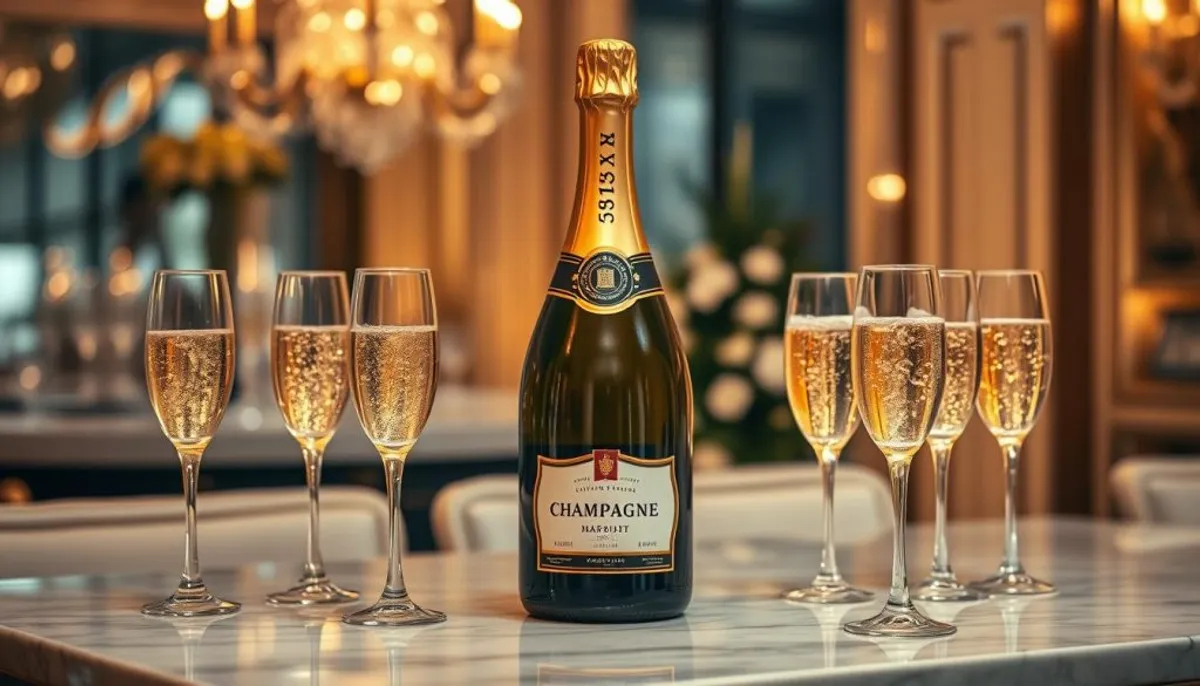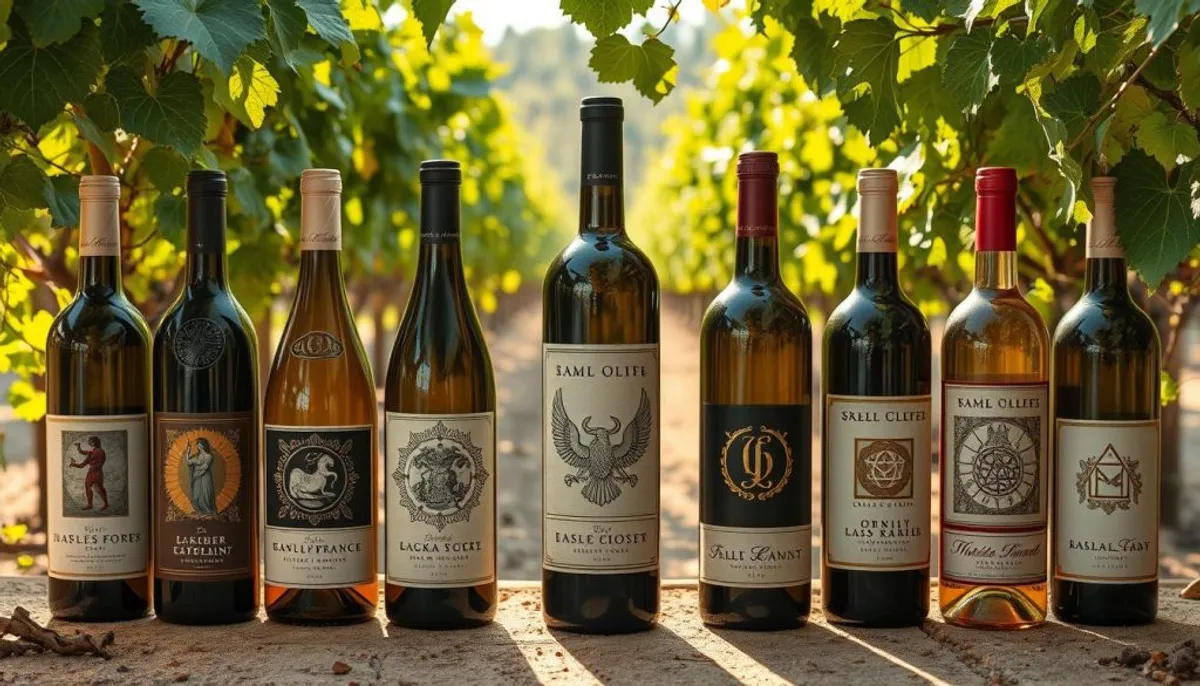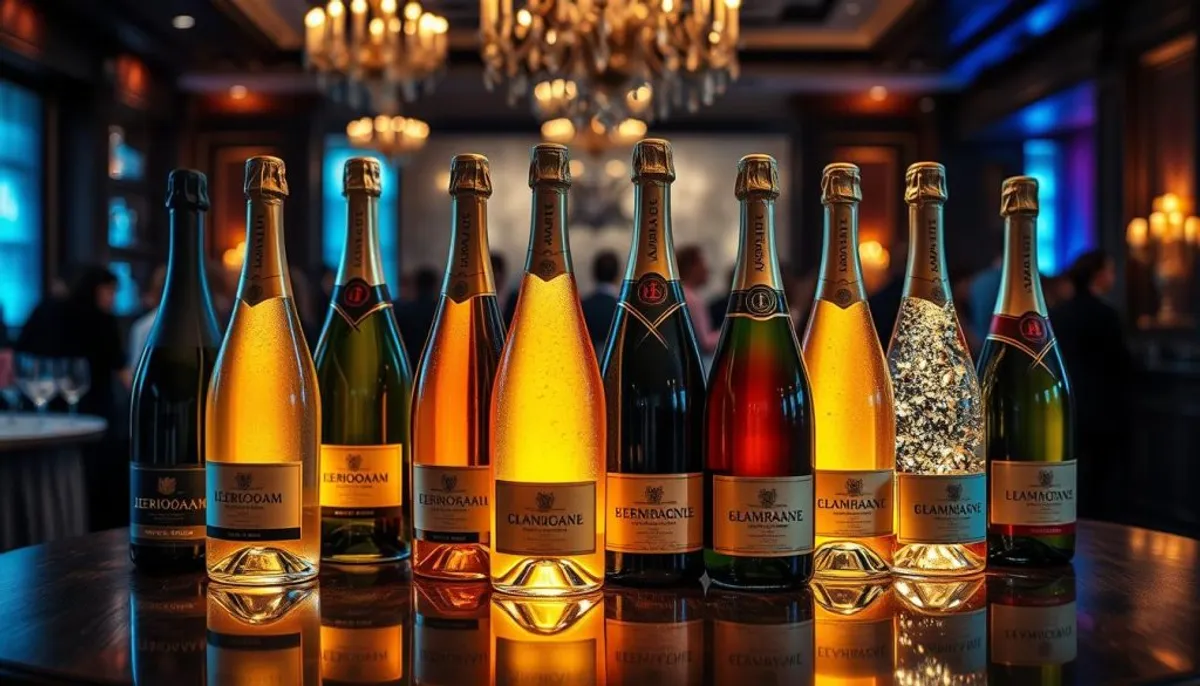Welcome to the realm of large format wines, where luxury and grandeur converge in a bottle. Double magnum champagne, a standout in wine collecting, has won the hearts of both casual enthusiasts and connoisseurs. These 3-liter bottles, equivalent to four standard champagne bottles, offer more than just visual appeal in the wine world.
Large format wines have become increasingly popular for their striking appearance and enhanced aging potential. Champagne houses have embraced this trend, producing these magnificent bottles for special occasions and discerning collectors. The allure of double magnums extends beyond their size, encompassing their rarity and prestige in the luxury wine market.

As we explore the world of large format wines, you’ll uncover the reasons behind their enduring appeal. These bottles boast impressive shelf presence and superior aging capabilities, offering a unique experience for wine aficionados. Whether you’re planning a grand celebration or expanding your wine collection, grasping the allure of these larger-than-life bottles is essential.
Key Takeaways
- Double magnum champagne bottles contain 3 liters of wine
- Large format wines are popular for special occasions and collecting
- These bottles offer superior aging potential compared to standard sizes
- Double magnums are rare and prestigious in the luxury wine market
- Understanding large format wines enhances the wine enthusiast’s experience
Understanding Large Format Wine Bottles
Wine bottle sizes have undergone significant changes, influenced by advancements in wine history and preservation methods. Today, large format wines span from 150cl to an impressive 27 litres. These sizes cater to the needs of both collectors and enthusiasts, offering unique advantages.
Evolution of Wine Bottle Sizes
The wine industry has witnessed a remarkable evolution in bottle sizes. The spectrum ranges from the standard 750ml to the colossal 30-liter Melchizedeks. Magnums, with their 1.5 liters, are often chosen for special events. Larger formats, such as Jeroboams and Balthazars, are highly sought after by collectors.
Historical Significance of Large Formats
Large format bottles hold a significant place in wine history. Named after biblical figures, they add an element of grandeur to any collection. Beyond their aesthetic appeal, these bottles serve a practical purpose in wine preservation. Experts like Pierre Seillan and Jean-Baptiste Lécaillon highlight that wines in larger formats age more slowly. This slow aging process allows for the development of complex flavors over time. Additionally, those interested in the market can find valuable insights into chandigarh liquor prices, which reflect the evolving trends in wine and spirits.
The Role of Cork in Large Format Development
Cork sealing has been instrumental in the evolution of large format wines. This natural material facilitates minimal oxygen exchange, essential for long-term storage. The adoption of cork in oversized bottles has transformed wine preservation. It enables wines to age gracefully for decades, preserving their quality and flavor.
| Bottle Size | Capacity (Liters) | Equivalent Standard Bottles | Wine Glasses |
|---|---|---|---|
| Magnum | 1.5 | 2 | 8 |
| Double Magnum (Jeroboam) | 3 | 4 | 16 |
| Rehoboam | 4.5 | 6 | 24 |
| Imperial (Methuselah) | 6 | 8 | 32 |
| Balthazar | 12 | 16 | 64 |
Double Magnum Champagne: Size and Specifications
Double magnum size champagne bottles, also known as Jeroboams, are impressive large format champagne vessels. These bottles hold 3 liters or 300cl of bubbly, equivalent to four standard 75cl bottles. The champagne bottle dimensions of a double magnum are truly eye-catching, standing approximately 18 inches tall and 5 inches wide.
Large format champagne bottles come in various sizes, each with unique characteristics. Let’s explore the range of champagne bottle sizes and their capacities:
| Bottle Name | Capacity (cl) | Equivalent Standard Bottles | Approx. Glasses Served |
|---|---|---|---|
| Standard | 75 | 1 | 6-8 |
| Magnum | 150 | 2 | 12 |
| Jeroboam (Double Magnum) | 300 | 4 | 24 |
| Methuselah | 600 | 8 | 48 |
| Salmanazar | 900 | 12 | 72 |
| Balthazar | 1200 | 16 | 96 |
| Nebuchadnezzar | 1500 | 20 | 120 |
Double magnum champagne bottles offer an impressive presentation for special occasions. Their size not only makes a statement but also impacts the aging process of the champagne inside. The larger volume allows for slower maturation, often resulting in more complex flavors and a smoother taste profile. Additionally, a magnum champagne bottle serves as a stunning centerpiece, elevating the overall experience of any celebration.
The Biblical Names Behind Large Format Bottles
Wine bottle names are deeply rooted in biblical references and wine traditions. Large format bottles often carry the names of kings and pivotal figures from the Bible. This adds a layer of historical significance to these impressive vessels.
Origin of Bottle Naming Traditions
The tradition of naming wine bottles after biblical characters spans centuries. It highlights the cultural significance of wine in religious ceremonies and historical events. Large format bottles, with their grand names, mirror their impressive size and stature.
Famous Biblical Characters in Wine Nomenclature
Many wine bottle names are inspired by notable biblical figures:
- Jeroboam: Named after the first king of Israel, holds 4 standard bottles
- Methuselah: Inspired by the oldest man in the Bible, contains 8 bottles
- Salmanazar: Named for an Assyrian king, equals 12 regular bottles
- Balthazar: One of the Three Wise Men, holds 16 bottles
- Nebuchadnezzar: The Babylonian king, contains 20 standard bottles

Modern Interpretations of Historical Names
Today, winemakers continue to honor these traditional names while introducing new sizes. The Melchizedek, also known as Midas, is the largest bottle, holding an impressive 40 standard bottles of wine. This blend of historical reverence and modern innovation keeps wine traditions alive. It appeals to both contemporary collectors and enthusiasts.
| Bottle Name | Biblical Reference | Equivalent in Standard Bottles |
|---|---|---|
| Jeroboam | First King of Israel | 4 |
| Rehoboam | King of Judah | 6 |
| Methuselah | Oldest Man in the Bible | 8 |
| Salmanazar | Assyrian King | 12 |
| Balthazar | One of the Three Wise Men | 16 |
Benefits of Large Format Wine Storage
Large format wine storage presents distinct advantages for aficionados and collectors. These oversized bottles are adept at preserving wine quality and enhancing the aging process. Additionally, implementing champagne affordability strategies can further benefit collectors by making larger formats more accessible. We will examine the primary benefits of storing wine in larger formats.
Aging Potential and Wine Development
Large bottles slow down the aging process, allowing flavors to mature gradually. The reduced air-to-wine ratio in these formats leads to slower oxidation. This slower aging often results in more complex and nuanced wines over time.
Temperature Stability Advantages
Temperature control is vital for wine aging. Large format bottles, with their thicker glass, offer better insulation against temperature fluctuations. This stability protects the wine from rapid aging, helping to maintain its intended flavor profile.
Impact on Wine Quality
The unique conditions in large bottles contribute to improved wine quality. The slower aging and better temperature control allow wines to develop more harmoniously. Collectors often prefer large formats for their potential to produce exceptional wines.
| Bottle Size | Volume (Liters) | Equivalent Standard Bottles |
|---|---|---|
| Double Magnum | 3 | 4 |
| Jeroboam (Bordeaux) | 5 | 6.67 |
| Imperiale | 6 | 8 |
| Salmanazar | 9 | 12 |
| Balthazar | 12 | 16 |
Large format wine storage has gained popularity among collectors and wine enthusiasts. The market for these bottles is expanding, with on-premise sales showing double-digit growth in states like New York and California. Bordeaux wines, in particular, are favored by collectors in the Northeast US and Asia, alongside magnums from Burgundy, premium California Cabernets, and the exquisite magnum champagne bottle.
Collecting Large Format Wines
The world of wine collecting has evolved, embracing large bottle collections as a new frontier. These grand vessels serve as more than mere containers; they symbolize prestige and offer distinct advantages for both enthusiasts and investors. From magnums to nebuchadnezzars, these rare wines have become coveted treasures in the realm of rare vintages.
The charm of large format bottles stems from their scarcity and superior aging capabilities. A magnum, with its 1.5 liters, ages more slowly than standard bottles, thanks to a lower air-to-wine ratio. This slower oxidation enhances the wine’s complexity over time, elevating its appeal as an investment.
Collectors are drawn to these rare wines for their striking appearance and potential for value growth. For instance, a La Tâche 2000 from Domaine de la Romanée-Conti, sold in three 3-liter bottles, fetched an impressive 1 million HKD at auction. Such transactions underscore the investment allure of large format wines.
| Bottle Size | Volume | Equivalent Standard Bottles |
|---|---|---|
| Magnum | 1.5 liters | 2 |
| Double Magnum | 3 liters | 4 |
| Jeroboam (Champagne) | 3 liters | 4 |
| Jeroboam (Bordeaux) | 4.5 liters | 6 |
| Methuselah/Imperial | 6 liters | 8 |
Wine aficionados often concentrate on renowned producers such as Château Haut-Brion, Mouton Rothschild, and Domaine de la Romanée-Conti. These esteemed wineries present their most exceptional vintages in various large formats. This exclusivity significantly enhances the allure of large bottle collections.
The Science Behind Large Format Aging
Large format wines undergo a distinct aging process compared to standard bottles. This process is influenced by several factors, shaping the wine’s evolution over time. We will examine the science behind large format aging and its impact on wine quality.
Oxygen Exposure and Ullage
Ullage, the gap between the wine and the cork, is pivotal in wine oxidation. In large format bottles, the air-to-wine ratio is lower, leading to slower oxidation. This gradual oxidation enables more controlled aging, often resulting in more complex flavors.
Glass Thickness and Temperature Control
Large format bottles have thicker glass, enhancing insulation. This improved insulation is crucial for maintaining consistent wine chemistry during aging. The better temperature control contributes to a more predictable and desirable aging outcome.
Chemical Evolution in Large Bottles
The unique conditions in large format bottles lead to a distinct chemical evolution. A study on champagne vintages aged between 25 and 47 years uncovered fascinating insights into bubble preservation:
- A standard 750ml bottle was predicted to have a shelf-life of 40 years
- A 1.5L Magnum was estimated to last 82 years
- A 3L Jeroboam could potentially keep its bubbles for 132 years
This extended shelf-life in larger bottles is attributed to slower chemical reactions. These reactions allow for more nuanced flavor development over time. The gradual changes in wine chemistry result in a more refined and complex taste profile. Additionally, collectors should be aware of potential inner ear problems that can arise from prolonged exposure to the vibrations caused by large format bottles being opened, which makes large format bottles highly sought after by collectors and enthusiasts.
| Bottle Size | Volume | Equivalent Standard Bottles | Estimated Bubble Preservation |
|---|---|---|---|
| Standard | 750ml | 1 | 40 years |
| Magnum | 1.5L | 2 | 82 years |
| Jeroboam | 3L | 4 | 132 years |
Investment Value of Large Format Bottles
The rare wine market has witnessed a notable increase in the allure of large format bottles. These oversized containers have emerged as a pivotal element in wine investment strategies. Auction prices have begun to reflect their growing popularity among wine collectors.
Recent statistics reveal a substantial shift in the Champagne trade. Magnum sales rose from 6.9% to 14.9% of total trade between May 2021 and April 2022. This represents a 130% increase in trade volume, underscoring the escalating demand for larger formats.
The investment potential of large format bottles is clear in their price premiums. For example, Louis Roederer Cristal 2008 in 600cl bottles commanded a 175% premium over standard 75cl bottles. Dom Perignon 2008 in 300cl bottles fetched a 145% premium.
| Wine | Bottle Size | Premium |
|---|---|---|
| Louis Roederer Cristal 2008 | 600cl | 175% |
| Dom Perignon 2008 | 300cl | 145% |
| Taittinger Comtes de Champagne 2006 | 150cl | 45% |
A Jeroboam of the 1945 Chateau Mouton-Rothschild sold for $310,700 at a Sotheby’s auction in 2007. This sale exemplifies the exceptional value that rare, large format wines can attain in the collector’s market.
Serving and Handling Large Format Wines
Large format wines necessitate meticulous care in storage and service. Adequate handling is crucial for a superior experience when indulging in these grand bottles.
Proper Storage Techniques
Store large format wines horizontally in a cool, dark environment. Maintain temperatures between 45°F and 65°F (8°C to 18°C) for optimal preservation. For bottles exceeding 1.5L, a slight tilt can alleviate cork pressure and prevent cork protrusion.
Decanting Methods
Decanting large bottles necessitates precision. Stand the bottle upright a day prior to serving to allow sediments to settle. Utilize a large decanter and pour slowly to avoid disturbing the sediment. This method aerates the wine, enhancing its flavors.
Temperature Service Guidelines
Serve red wines at 60-65°F (15-18°C) and white wines at 45-50°F (7-10°C). Gradually chill large bottles to achieve the ideal wine temperature. This meticulous wine handling guarantees the finest tasting experience.
| Bottle Size | Volume | Servings |
|---|---|---|
| Standard | 750ml | 5 glasses |
| Magnum | 1.5L | 10 glasses |
| Double Magnum | 3L | 20 glasses |
| Imperial | 6L | 40 glasses |
Wine service for large bottles is an art form that reflects the rich traditions of hungarian wine culture. Take your time, employ proper equipment, and relish the unique experience of sharing these magnificent wines.
Popular Large Format Champagne Houses

Luxury champagne aficionados and collectors frequently pursue large format bottles from celebrated champagne houses. These prestige cuvées, available in grand sizes, are ideal for commemorating special occasions and enhancing fine dining experiences. For those seeking the ultimate in indulgence, luxury accommodations champagne can elevate the entire experience, making it truly unforgettable.
Dom Pérignon, Krug, Bollinger, and Louis Roederer are among the elite champagne producers renowned for their large format offerings. They regularly unveil double magnums and larger sizes of their esteemed champagnes. This attracts both collectors and high-end event planners.
Mumm Champagne distinguishes itself by providing magnum formats for all their cuvées, including Mumm Cordon Rouge and Mumm Le Rosé. These 1.5-liter bottles, capable of serving 12-14 flutes, are perfect for celebrations.
For wine connoisseurs, large format champagne offers distinct advantages:
- Slower oxidation process, allowing the wine to age gracefully
- Enhanced protection against temperature changes
- Improved development of flavors and aromas
Prestigious restaurants globally feature these grand bottles in their wine lists. Commander’s Palace, for instance, boasts over 20 large-format bottles. Metropolitan Grill offers 120 magnums and double magnums. Pappas Bros. Steakhouse Dallas goes further, with over 400 large-format options from their extensive 4,100-label collection.
Whether for a special event or a collector’s milestone, large format champagne from these esteemed producers guarantees an unforgettable tasting experience. It showcases the finest qualities of luxury champagne.
Special Occasions and Large Format Wines
Large format wines bring an air of opulence to special events and wine celebrations. These bottles, with their impressive stature, serve as striking focal points. They are ideal for commemorating significant moments, such as those involving the november birthstone, which symbolizes strength and healing.
Celebrations and Events
Large format wines can elevate any celebration, from weddings to milestone birthdays. A double magnum of champagne, capable of filling 16 glasses, is perfect for toasting a wedding party. For retirement or anniversaries, a 6-liter Methuselah, offering 32 servings, ensures all guests can participate in the celebration.
Corporate Gifting
Large bottles are exceptional corporate gifts, highlighting the value of business relationships. A magnum of premium Bordeaux, such as Chateau Lafite-Rothschild 2010 at $10,500, conveys deep appreciation. For significant business achievements, a Nebuchadnezzar (15L) of sparkling wine can celebrate success with the entire team.
Collector’s Milestones
Wine enthusiasts often celebrate personal achievements with large format wines. A double magnum of Chateau d’Yquem 2007, priced at $4,050, could mark a career peak. Collectors might choose a Balthazar (12L) from a notable vintage for wine gifting or hosting exclusive tastings.
Whether for intimate gatherings or grand galas, large format wines turn ordinary moments into unforgettable memories. They are perfect for wine celebrations of all scales.
Conclusion
Our exploration into the realm of double magnum champagne and luxury wines has unveiled their unique allure. These grand bottles cater to both the enthusiast and the investor, boasting superior protection against environmental factors. Their larger stature and thicker glass shield against heat, light, and temperature fluctuations. This results in a slower aging process, which in turn enhances the wine’s flavor profile.
The trend of champagne collecting is on the rise, attracting both aficionados and investors. The slow oxidation in these larger formats leads to more refined maturation compared to standard sizes. For instance, a double magnum Chateau Palmer 2015 can be acquired for approximately 1,270 Euros. This highlights the potential for substantial returns on investment in the realm of large format wines.
Despite the challenges posed by storage and pouring, the advantages of large format wines far outweigh these minor hurdles. From the biblical origins of bottle sizes to the scientific aspects of aging, these wines promise a rich and immersive experience. Whether for a celebratory toast or to expand one’s collection, these wines remain a captivating choice for connoisseurs globally, enriching any cellar with their presence.
RelatedRelated articles



